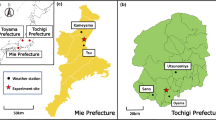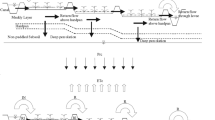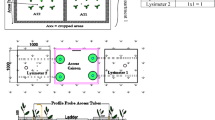Abstract
A water balance model for paddy is developed primarily based on the principle of conservation of mass of soil–water within the root zone. The water balance for paddy is different from that of field crops because paddy requires standing water in the field during most of its growth period. This model requires soil, crop and meteorological data as inputs. This user friendly model was developed using computer programmes C and Visual Basic (VB) 6.0. It simulates various water balance components such as evapotranspiration, deep percolation, surface runoff and depth of irrigation water and ponding depth in the field on a daily basis. For estimation of deep percolation loss, physically based saturated and unsaturated flow processes are incorporated into the model to consider ponding (if there is standing water in the field), saturation (if moisture content of soil is in between field capacity and saturation) and depletion (if moisture content of soil is below field capacity) phases of paddy field. This article presents development of a user friendly water balance model for paddy and also its validation using published data.









Similar content being viewed by others
References
Agrawal MK, Panda SN, Panigrahi B (2004) Modeling water balance parameters for rainfed rice. J Irrigation Drainage Eng 130(2):129–139
Allen RG, Pereira LS, Raes D, Smith M (1998) Crop evapotranspiration—guidelines for computing crop water requirements. FAO irrigation and drainage paper 56. Food and Agriculture Organization of the United Nations (FAO), Rome
Angus JF, Zandstra HG (1980) Climatic factors and the modeling of rice growth and yield. Proceedings of the WMO-IRRI symposium on Agrometeorology of the rice crop. International Rice Research Institute (IRRI), Los Banos, pp 189–190
Arora VK (2006) Application of a rice growth and water balance model in an irrigated semi-arid subtropical environment. Agric Water Manag 83(1–2):51–57
Barker R, Herdt RW (1985) The rice economy of Asia. Resources for the future Inc., Washington, DC
Belmans C, Wesseling JG, Feddes RA (1983) Simulation model for water balance of a cropped soil: SWATRE. J Hydrol 63:271–286
Bolton FR, Zandstra HG (1981) A soil moisture based yield model of wetland rainfed rice. Research Paper 62. International Rice Research Institute (IRRI), Los Banos
Brooks RH, Corey AT (1966) Properties of porous media affecting fluid flow. J Irrigation Drainage Eng 92:61–88
Brown KW, Turner FT, Thomas JC, Deuel LE, Keener ME (1978) Water balance of flooded rice paddies. Agric Water Manag 1:277–291
BRRI (1984) Annual internal review report for 1983. Agricultural Engineering Division, Bangladesh Rice Research Institute (BRRI), Gazipur, p 74
Chen SK, Liu CW, Huang HC (2002) Analysis of water movement in paddy rice fields. II: Simulation studies. J Hydrol 268:259–271
Darcy H (1856) Les fontaines publiques de la ville de Dijon. Victor Dalmont, Paris
Doorenbos J, Pruitt WO (1977) Guidelines for predicting crop water requirements. Irrigation and drainage paper 24. Food and Agriculture Organization of the United Nations (FAO), Rome
George BA, Raghuwanshi NS, Singh R (2004) Development and testing of a GIS integrated irrigation scheduling model. Agric Water Manag 66(3):221–237
Hama T, Nakamura K, Kawashima S (2010) Effectiveness of cyclic irrigation in reducing suspended solids load from a paddy-field district. Agric Water Manag 97(3):483–489
Hargreaves GL, Hargreaves GH, Riley JP (1985) Agricultural benefits for Senegal River basin. J Irrigation Drainage Eng 111:113–124
Inthavong T, Tsubo M, Fukai S (2011) A water balance model for characterization of length of growing period and water stress development for rainfed lowland rice. Field Crops Res 121(2):291–301
IRRI (1989) IRRI toward 2000 and beyond. International Rice Research Institute (IRRI), Los Banos
Jang TI, Kim HK, Seong CH, Lee EJ, Park SW (2012) Assessing nutrient losses of reclaimed wastewater irrigation in paddy fields for sustainable agriculture. Agric Water Manag 104:235–243
Janssen M, Lennartz B (2009) Water losses through paddy bunds: methods, experimental data, and simulation studies. J Hydrol 369(1–2):142–153
Kampen J (1970) Water losses and water balance studies in low land rice irrigation. Ph.D. Dissertation, Cornell University, Ithaca, USA
Kar G, Verma HN (2005) Climatic water balance, probable rainfall, rice crop water requirements and cold periods in AER 12.0 in India. Agric Water Manag 72(1):15–32
Khepar SD, Yadav AK, Sondhi SK, Siag M (2000) Water balance model for paddy fields under intermittent irrigation practices. Irrig Sci 19(4):199–208
Kim HK, Jang TI, Im SJ, Park SW (2009) Estimation of irrigation return flow from paddy fields considering the soil moisture. Agric Water Manag 96(5):875–882
Liu CW, Chen SK, Jou SW, Kuo SF (2001) Estimation of the infiltration rate of a paddy field in Yun-Lin, Taiwan. Agric Syst 68:41–54
McMennamy JA, O’Toole JC (1983) RICEMOD: a physiologically based rice growth and yield model. Research Paper 87. International Rice Research Institute (IRRI), Los Banos
Mishra A (1999) Irrigation and drainage needs of transplanted rice in diked rice fields of rainfed medium lands. Irrig Sci 19:47–56
Mishra A, Ghorai AK, Singh SR (1998) Rainwater, soil and nutrient conservation in rainfed rice lands in eastern India. Agric Water Manag 38:45–57
Mishra SK, Sarkar R, Dutta S, Panigrahy S (2008) A physically based hydrological model for paddy agriculture dominated hilly watersheds in tropical region. J Hydrol 357(3–4):389–404
Mizutani M, Kalita PK, Shinde D (1989) Effect of different rice varieties and mid term drainage practices on water requirement in dry season paddy—observational studies on water requirement of low land rice in Thailand. J Irrigation Eng Rural Plan 17:6–20
Moroizumi T, Hamada H, Sukchan S, Ikemoto M (2009) Soil water content and waterbalance in rainfed fields in northeast Thailand. Agric Water Manag 96(1):160–166
Mualem Y (1976) A new model for predicting the hydraulic conductivity of unsaturated porous media. Water Resour Res 12:513–522
Odhiambo LO, Murty VVN (1996) Modeling water balance components in relation to field layout in lowland paddy fields. II: Model application. Agric Water Manag 30(2):201–216
Pande HK (1976) Water management practices and rice cultivation in India. In Symposium on water management in rice field. Proceedings of a symposium on Tropical Research Centre, Ministry of Agriculture and Forestry, Tokyo, pp 231–249
Panigrahi B, Panda SN, Mull R (2001) Simulation of water harvesting potential in rainfed ricelands using water balance model. Agric Water Manag 69(3):165–182
Planning Commission (2002) Chapter 8.1: irrigation, flood control and command area development. Section VIII: infrastructure, Vol. II: sectoral policies and programmes, tenth five year plan. Govt. of India, New Delhi
Polyanin AD (2002) Handbook of linear partial differential equations for engineers and scientists. CRC Press, Boca Raton
Reshmidevi TV, Jana R, Eldho TI (2008) Geospatial estimation of soil moisture in rain-fed paddy fields using SCS-CN-based model. Agric Water Manag 95(4):447–457
Roy D, Panda SN, Panigrahy B (2009) Waterbalance simulation model for optimal sizing of on-farm reservoir in rainfed farming system. Comput Electron Agric 65(1):114–124
Russo D (1988) Determining soil hydraulic properties by parameter estimation: on the selection of a model for the hydraulic properties. Water Resour Res 24:453–459
SCS (1967) Irrigation water requirements. Technical release 21 (TR-21). Soil Conservation Service (SCS), USDA, Washington, DC
Smith M (1992). CROPWAT: A computer program for irrigation planning and management. FAO irrigation and drainage paper 46. Food and Agriculture Organization of the United Nations (FAO), Rome
Silva CSD, Rushton KR (2008) Representation of rainfed valley ricefields using a soil–water balance model. Agric Water Manag 95(3):271–282
Singh CB, Aujla TS, Sandhu BS, Khera KL (1996) Effect of transplanting date and irrigation regime on growth, yield and water use in rice (Oryza sativa) in northern India. Indian J Agric Sci 66:137–141
ten Berge HFM, Jansen DM, Rappoldt K, Stol W (1992) The soil water balance model SAWAH: user’s guide and outline. CABO-TPE simulation reports series 22. Centre for Agrobiological Research (CABO), Wageningen
Tsubo M, Fukai S, Tuong T, Ouk M (2007) A water balance model for rainfed lowland rice fields emphasising lateral water movement within a toposequence. Ecol Model 204(3–4):503–515
van Genuchten MTh (1980) A closed-form equation for predicting the hydraulic conductivity of unsaturated soils. Soil Sci Soc Am J 44:892–898
van Genuchten MTh, Nielson DR (1985) On describing and predicting the hydraulic properties of unsaturated soils. Ann Geophys 3(5):615–628
Walker SH, Rushton KR (1984) Verification of lateral percolation losses from irrigated rice fields by numerical model. Agric Water Manag 71:335–351
Walker SH, Rushton KR (1986) Water losses through bunds of irrigated rice fields interpreted through an analogue model. Agric Water Manag 11:59–73
Wickham TH, Singh VP (1978) Water movement through wet soils. Soils and rice. International Rice Research Institute (IRRI), Los Banos, pp 337–358
Xie X, Cui Y (2011) Development and test of SWAT for modeling hydrological processes in irrigation districts with paddy rice. J Hydrol 396(1–2):61–71
Yadav S, Li T, Humphreys E, Gill G, Kukal SS (2011) Evaluation and application of ORYZA2000 for irrigation scheduling of puddled transplanted rice in north west India. Field Crops Res 122(2):104–117
Zaman SMH (1986) Current status and prospects for rainfed food grain production in Bangladesh. BRRI, Gazipur
Author information
Authors and Affiliations
Corresponding author
Rights and permissions
About this article
Cite this article
Bhadra, A., Bandyopadhyay, A., Singh, R. et al. Development of a user friendly water balance model for paddy. Paddy Water Environ 11, 331–341 (2013). https://doi.org/10.1007/s10333-012-0324-4
Received:
Revised:
Accepted:
Published:
Issue Date:
DOI: https://doi.org/10.1007/s10333-012-0324-4




